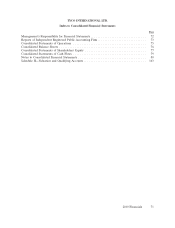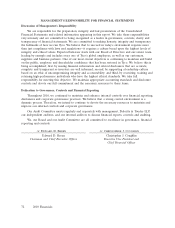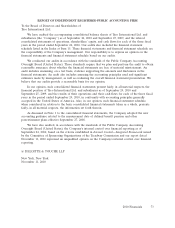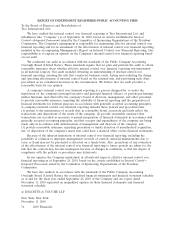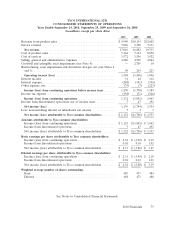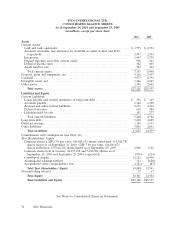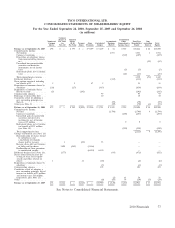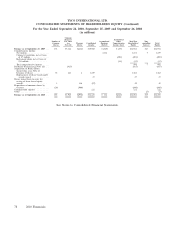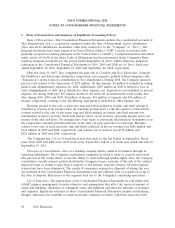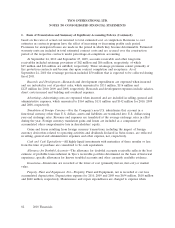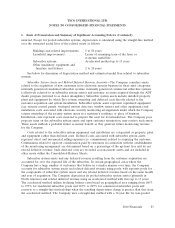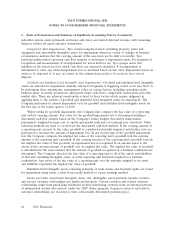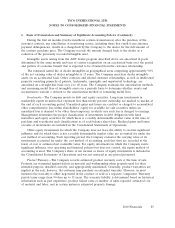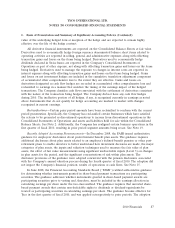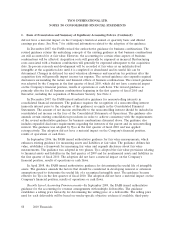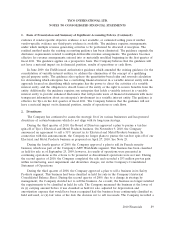ADT 2010 Annual Report Download - page 169
Download and view the complete annual report
Please find page 169 of the 2010 ADT annual report below. You can navigate through the pages in the report by either clicking on the pages listed below, or by using the keyword search tool below to find specific information within the annual report.TYCO INTERNATIONAL LTD.
NOTES TO CONSOLIDATED FINANCIAL STATEMENTS
1. Basis of Presentation and Summary of Significant Accounting Policies (Continued)
asset impairments, useful lives for depreciation and amortization, loss contingencies (including legal,
environmental and asbestos reserves), net realizable value of inventories, fair values of financial
instruments, estimated contract revenue and related costs, income taxes and tax valuation allowances,
and pension and postretirement employee benefit expenses. Actual results could differ materially from
these estimates.
Revenue Recognition—The Company recognizes revenue principally on four types of transactions—
sales of products, sales of security systems, billings for monitoring and maintenance services and
contract sales.
Revenue from the sales of products is recognized at the time title and risks and rewards of
ownership pass. This is generally when the products reach the free-on-board shipping point, the sales
price is fixed and determinable and collection is reasonably assured.
Provisions for certain rebates, sales incentives, trade promotions, product returns and discounts to
customers are accounted for as reductions in determining sales in the same period the related sales are
recorded. These provisions are based on terms of arrangements with direct, indirect and other market
participants. Rebates are estimated based on sales terms, historical experience and trend analysis.
Sales of security monitoring systems may have multiple elements, including equipment, installation,
monitoring services and maintenance agreements. The Company assesses its revenue arrangements to
determine the appropriate units of accounting. When ownership of the system is transferred to the
customer, each deliverable provided under the arrangement is considered a separate unit of accounting.
Revenues associated with sale of equipment and related installations are recognized once delivery,
installation and customer acceptance is completed, while the revenue for monitoring and maintenance
services are recognized as services are rendered. Amounts assigned to each unit of accounting are
based on an allocation of total arrangement consideration using each deliverable’s relative fair value.
Revenue recognized for equipment and installation is limited to the lesser of their allocated amounts
under the relative fair value method or the non-contingent up-front consideration received at the time
of installation, since collection of future amounts under the arrangement with the customer is
contingent upon the delivery of monitoring and maintenance services.
For transactions in which the Company retains ownership of the subscriber system asset, fees for
monitoring and maintenance services are recognized on a straight-line basis over the contract term.
Non-refundable fees received in connection with the initiation of a monitoring contract, along with
associated direct and incremental selling costs, are deferred and amortized over the estimated life of
the customer relationship.
While the Company does not expect situations where fair value cannot be objectively determined
for sales of security systems and services, if such cases were to arise, the Company’s policy is to
recognize revenue for all elements over the contract life.
Revenue from the sale of services is recognized as services are rendered. Customer billings for
services not yet rendered are deferred and recognized as revenue as the services are rendered and the
associated deferred revenue is included in current liabilities or long-term liabilities, as appropriate.
Contract sales for the installation of fire protection systems, large security intruder systems and
other construction-related projects are recorded primarily under the percentage-of-completion method.
Profits recognized on contracts in process are based upon estimated contract revenue and related total
cost of the project at completion. The extent of progress toward completion is generally measured
2010 Financials 81


